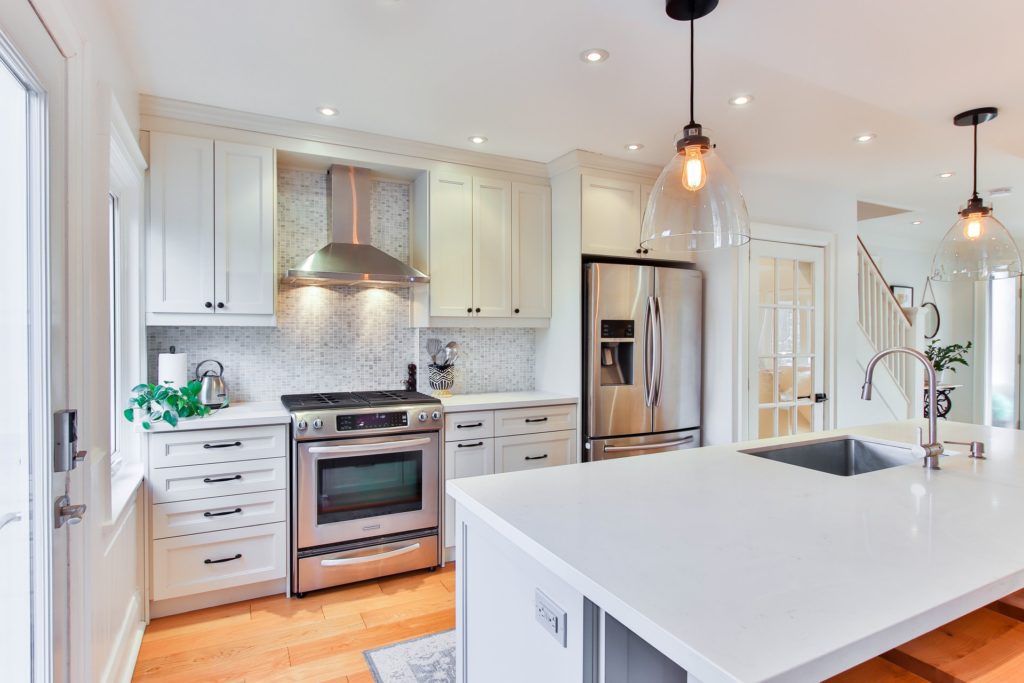There are many choices and decisions to be made during a kitchen remodel, and they can quickly become overwhelming. This is especially true for decisions that could affect the health or safety of your home. Ventilation options for the kitchen are one of those choices that can make homeowners feel too inexperienced to make the right decision. You don’t need to know everything about the number of amps required within your range hood in correlation to the heat your stovetop expels. However, it could be beneficial to understand why range hoods are essential, the difference between vented versus unvented, and the different range hood options.
Knowledge is power, and empowering yourself with the need to know information about range hoods will allow you to make an informed decision and feel good about it afterward.
 Why You Need a Range Hood
Why You Need a Range Hood
While it might feel obvious as to why a range hood within a kitchen is important, sometimes what feels like elementary level information can bring to light what aspects of the decision are important to you.
Safer and Healthier Air
First and foremost, the most important reason to include a range hood within your kitchen remodel is safety. When cooking, smoke and other airborne material can gunk up the air and make it hard to breathe. Now, we aren’t saying you burn everything! Even expert chefs create smoke, grease, or oil splatter that can cause a kitchen to fog up. This fog can be harmful to
breathe for extended periods and might even damage parts of your home.
With a range hood over the cooking surface, you can ensure that those grilled cheese disasters or bacon breakfast masterpieces don’t leave your home smelling of smoke.
Heat and Moisture Removal
Those stunning new cabinets that the carpenters will install in your brand new kitchen could potentially be ruined or damaged without proper ventilation. Heat and moisture are wood’s worst enemy, and plenty of it is created while cooking. With an excellent ventilation source, this extra heat and humidity can be expelled from the room and keep it from causing the wood to swell or expand.
Up to Code
Assuming you’ve spent the time and found a reputable Design-Build construction company, chances are you won’t have to worry about the remodel being up to code. Companies like these take all that worry and legal jargon off your plate so you can focus on fun decisions, like which range hood you’d like. However, it’s essential to know this going into a remodel.
Depending on a few factors, a range hood could be required and illegal to exclude from a kitchen remodel. These factors include where you live and the type of cooktop that is being used.
 Vented Versus Unvented Range Hood
Vented Versus Unvented Range Hood
Before diving into the differences between these two options, keep in mind that if you have a gas cooktop installed, you do not have the option to use an unvented range hood. If the cooktop is electric or induction, then there is an opportunity to select an unvented option.
Vented Hood
Simply put, hoods that are vented are attached to a duct (like an air duct) that pulls the air from the kitchen and blows it outside. This is the safest and cleanest option for venting out smoke, gas, or steam. So why would you ever choose an unvented option? If the cooktop and range are moved to a new location within the home, building and directing a whole new venting
system can quickly become expensive and complicated. This is where an unvented option could work better for the kitchen design and your wallet.
Unvented Hood
Unvented hoods do not attach to a duct; instead, they have a fan that uses multiple filters to clean and recirculate the air. Many fantastic unvented hood options can keep the air within the kitchen clean. However, you can not use this type of ventilation system when the cooktop is gas. It also might not be a great idea if you or others within the home are avid cooks. Filters can get dirty and need replacing quite often, and if they aren’t, they won’t be doing a good enough job to keep your family safe.
Types of Range Hoods
Now that we understand the difference between vented and unvented hoods and why a vent hood is vital to a kitchen remodel’s success, let’s dive into the five different types of range hoods.
Under-Cabinet Range Hood
Under-Cabinet hoods go…you guessed it, under the cabinets. Typically there is a section of the cabinet above the hood that acts as extra storage or decoration. Many of these hoods offer additional lighting and use the backside of the cabinet to vent to the outdoors.
Over-the-Range Microwave Vent
Many of us are familiar with the vents that come with microwaves when installed over the cooktop. These are convenient for smaller spaces where every inch counts. However, more often than not, these vents are unvented and will only clean the air with filters and recirculate it. As we know from our lesson on vented or unvented, this isn’t an issue for electric or induction cooktops but could cause a problem for those with gas stovetops.
 Wall-Mount Range Hood
Wall-Mount Range Hood
These types of hoods are probably the most versatile. Not only do they come in almost any style you could ever dream of, but they also come in vented and unvented versions. As you
might have guessed, they are installed onto the wall above the cooktop and do not require cabinets as a frame.
Ceiling-Mount Range Hood
Ideal for those with island cooktops, ceiling-mounted range hoods are installed directly into the ceiling. It’s a sleek look and can offer an opportunity for other items such as hanging pan racks to not look out of place hanging in the middle of the room. Of course, just like others on this list, they come with an extensive list of styles and designs.
Downdraft Vent Hood
Only just recently becoming popular, downdraft vents are installed behind the cooktop and before the counter. Many will pop up when needed and stay hidden when not. They are excellent options for a kitchen where space is limited or for cooktops located on an island. While a ceiling-hung range hood might feel obtrusive, downdraft vents are subtle.
Now you’re equipped with the information you need to decide which range hood option is best for you. For the other details and items you don’t want to have to deal with (like routing the ducts or calculating the amps needed), contact us today, and we can take care of it while you focus on the fun aspects of remodeling your home.


